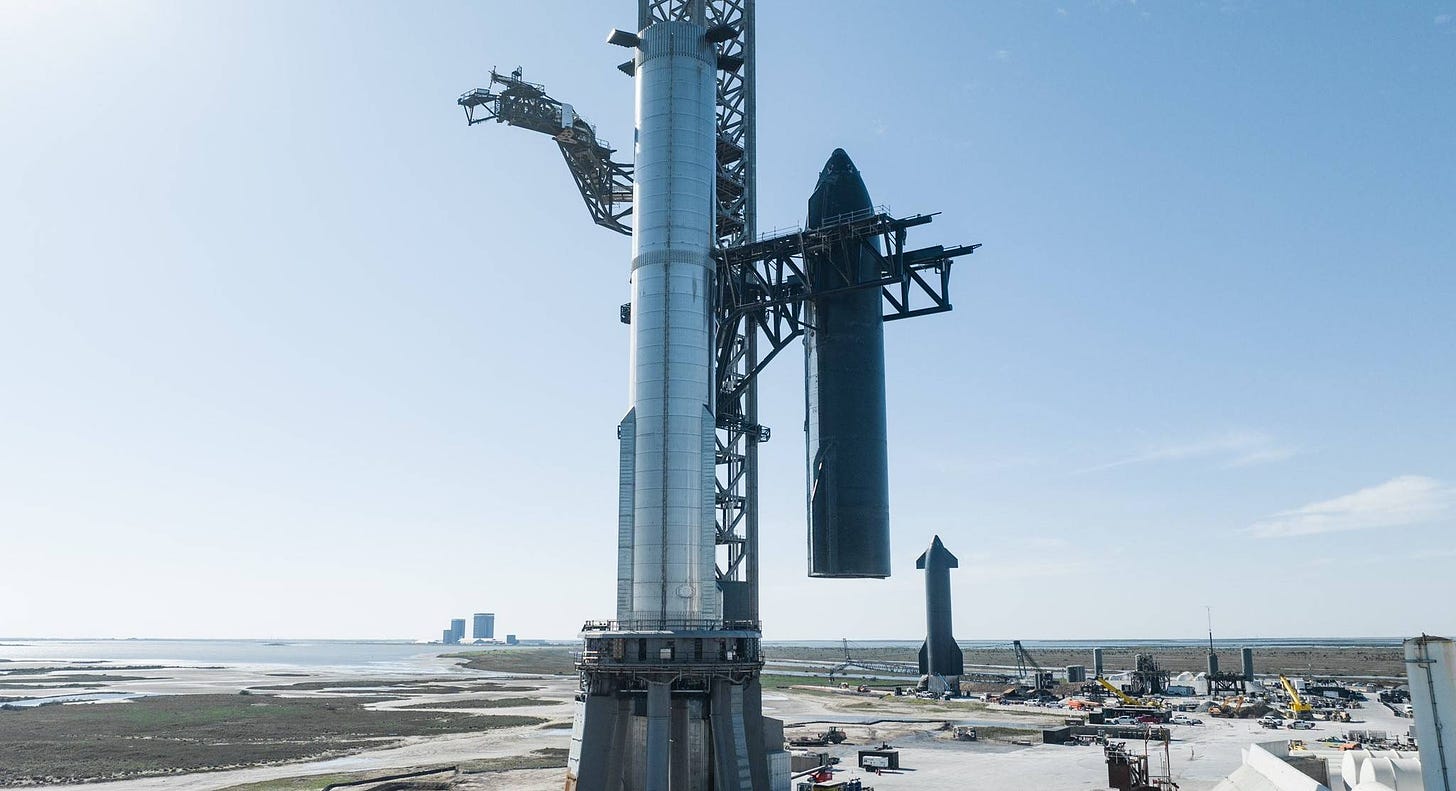SpaceX and US Military Will Build Hundreds of Mechazilla Launch Towers by 2030
The US military will need to build hundreds of Mechazilla launch towers by 2030.
The US military is planning to get to thousands of SpaceX flights per year and this will mean that the US military will need hundreds of Mechazilla launch towers.
As of February 2023, SpaceX’s Mechazilla launch towers are estimated to cost less than $100 million each. This cost did not go up that much with the water deluge system. The metal launch tower segments are not expensive, and the towers have robotic arms and the power to operate them. The US military is clearly eyeing thousands of flights per year using SpaceX Starship and hundreds of Mechazilla launch facilities. One hundred Mechazilla launch tower bases would cost about $10 billion.
The US military is worried about China building many more space launch facilities. The US military has about 700-850 military bases around the world. This definition of military base is based upon where US military presence is located.
Here is a github source of US troop deployments.
Many lists of US bases do not include places like Tower 22 in Jordan. Approximately 3,000 US troops are currently stationed in Jordan. The United States military has used the Tower 22 outpost, which was initially established as a Jordanian border outpost, since 2015 in an “advise and assist” mission, initially training rebels fighting the regime of Syrian president Bashar al-Assad and later aiding Kurds fighting the Islamic State.
US military base sites fall under two main categories:
Large bases or “Bases”: Defined as military installations larger than 4 hectares (10 acres) or worth more than $10 million. These bases typically have in excess of 200 US military personnel. 439 or 60 percent of the US’s foreign bases fall under this category.
Small bases or “Lily Pads”: These bases are smaller than 4 hectares(10 acres) or have a value of less than $10 million. These include cooperative security locations and forward operating sites. The remaining 40 percent of US foreign bases fall under this category.
Just connecting the largest military bases would need about 90 launch towers. IF they are flying each Starship twice per day for cargo, then a twenty Starship fleet would be 40 flights per day would be about 14000 flights per year. Twenty Starships would need about 120 SpaceX Raptor engines. IF the Starships could only fly 100 times before a major refit or replacement then they would need replacement or refit every two months.
Mass produced Starship with $250,000 per engine would cost about $4 to 10 million each. As of January 2022, the Boeing C-17 Globemaster III military jet costs around $340 million. $24 to $60 million per year for refit or replaced Starships would be still be cheaper and faster than the C-17 Globemaster III. The C-17 costs about $22000 per hour to operate and has 85 tons of payload capacity. The SpaceX Starship can have two to three times the payload capacity and would fly fifteen to thirty times faster than the C-17. This would mean the SpaceX Starship could do 40 to eighty times what the Globemaster does in an hour. This would justify up to $800k per hour for a SpaceX Starship transportation system.
Proof that US Military is Thinking about Thousands of SpaceX Starship per Year
If the US military is going to get to thousands of SpaceX flights per year, then the US military will need a hundred Mechazilla launch towers.
The Space Mobility Conference held by the Space Force at the Orange County Convention Center earlier this month revealed the SpaceX and military planning.
“Rocket cargo point-to-point is not the reason we’re building Starship,” said SpaceX senior adviser Gary Henry. “We’re building Starship to get to Mars.” [But] “what we’re finding is it’s a system we’re putting together that has profound impacts for national security, and one of them just happens to be rocket point-to-point.”
The big driver of that is the potential the military could use the rocket to send supplies, and perhaps even troops in the future, to anywhere in the world in less than an hour. Defense department officials began looking at the idea two decades ago but only recently has it come closer to reality.
“Envision a number of containers sitting in a warehouse down in [Cape] Canaveral, we go to an alert level, we pull them up, you start putting them on the rocket,” said Gregory Spanjers, chief scientist for the U.S. Air Force Research Lab. “At each successive alert level, your time to launch shrinks and shrinks and shrinks, and we can we get it down to one hour.
Spanjers said teams have already been making mockups of Starship’s cargo bay figuring out how to take advantage of a quick supply run.
Speed is the obvious draw, but the cost is dropping and getting closer to existing expenses for moving supplies.
Henry said SpaceX’s current fleet of Falcon 9 rockets with boosters originally designed to fly 10 times, but with future boosters that might go up as many as 40 times, have brought the price of flying payloads from about $4,500 per pound to about $900 per pound.
The Falcon 9’s have a capacity of 44,000 pounds to 132,000 pounds.
“But Starship is a very different animal,” he said. “Starship is fundamentally meant to be rapidly reusable … We designed the vehicle from the outset to fly 100 times, not 10 times, and it’s going to deliver [220,000 to 250,000 pounds] 100 to 115 metric tons to low-Earth orbit.”
He said Starship would bring the cost trajectory down to a starting point of $90 per pound. Musk has said he could see that dropping even more to $9 a pound down the road.
Henry said these are prices close to what one gets using a C-17 cargo plane transport, the supply workhorse of the military, but with flights that take hours instead of minutes.
“In a few years, we will be launching Starships hundreds, and soon thereafter, thousands of times a year,” he said. “And if just assuming you have a rapidly reusable system that could let’s say launch twice a day, from a single launch base, you’re going to find very, very quickly, we’re going to run out of places to launch.”
To meet its launch plans, it will need multiple launch towers from its existing launch sites at KSC, Texas and California, but SpaceX could spread its footprint to new launch sites down the line as well, and that could feed into point-to-point plans the military is interested in, Henry said.
“I think the answer is we’re going to need both as a company, but also as a nation, to fully leverage Starship,” he said. “We’re going to need a proliferation of launch sites [within the continental U.S.] and maybe even globally to fully capture this.”
Nextbigfuture discussed the clear value of SpaceX for Air Cargo over a year ago in a few videos.
Go paid at the $5 a month level, and we will send you both the PDF and e-Pub versions of “Government” - The Biggest Scam in History… Exposed! and a coupon code for 10% off anything in the Government-Scam.com/Store.
Go paid at the $50 a year level, and we will send you a free paperback edition of Etienne’s book “Government” - The Biggest Scam in History… Exposed! AND a 64GB Liberator flash drive if you live in the US. If you are international, we will give you a $10 credit towards shipping if you agree to pay the remainder.
Support us at the $250 Founding Member Level and get a signed high-resolution hardcover of “Government” + Liberator flash drive + Larken Rose’s The Most Dangerous Superstition + Art of Liberty Foundation Stickers delivered anywhere in the world. Our only option for signed copies besides catching Etienne @ an event.








Why does one country need over 850 offensive military bases around the world? In a word: paranoia.
Has no one seen Gravity.. Space junk future looming!!!